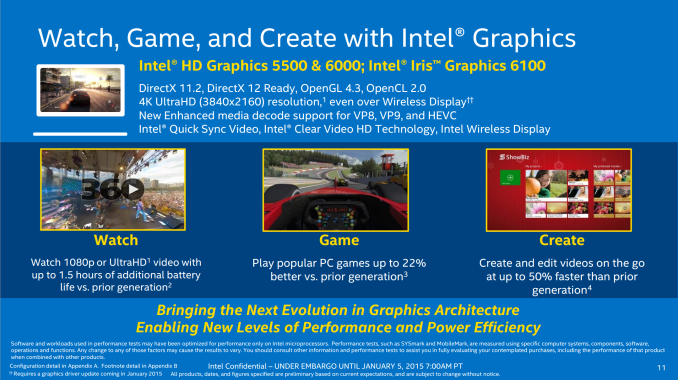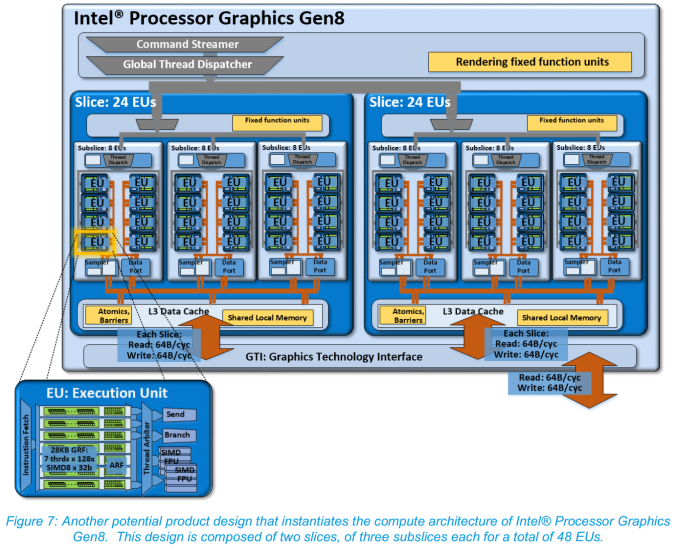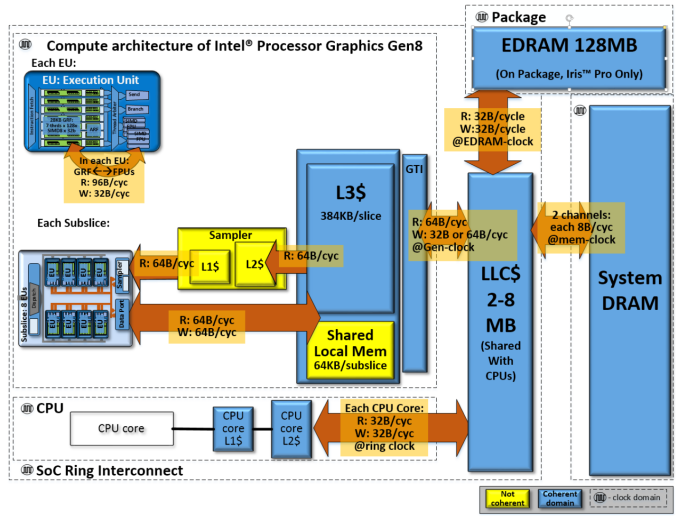Intel Releases Broadwell-U: New SKUs, up to 48 EUs and Iris 6100
by Ian Cutress on January 5, 2015 10:00 AM ESTBroadwell GPU Improvements
The new integrated graphics for Broadwell from Intel in the form of HD 5500, HD 6000 and Iris 6100 open up some very important functionality. DirectX 11.2, OpenGL 4.3 and OpenCL 2.0 are big scoring points, especially OpenCL 2.0 when it comes to graphics compute. This includes features such as shared memory coherency between CPU and GPU to allow transfer of pointer-rich memory structures and ultimately the beginnings of heterogeneous CPU + GPU compute.
‘DirectX 12 Ready’ is somewhat of an interesting case, and it depends on Microsoft’s final specifications. At this point in time Intel state that they conform to as much of DirectX 12 feature set that they can get their hands on with their relationship with Microsoft, and barring any major addition or change, should be compatible. UHD-4K is also now supported through the HDMI 1.4b interface, albeit limited to 24 Hz.
Support for HEVC is also present in terms of a combined (hybrid) hardware and software solution, just as it was on Core-M. Intel stated that as parts of the H.264 algorithm are near if not identical to those of the H.265, with a small tweak to the hardware it can be used for both. This is still not an all-encompassing hardware acceleration, but it does aim at some parts of the codec. I would speculate that if a full section of the silicon could be made for complete hardware acceleration, it might eat into certain power budgets.
GPU Slices
Although mentioned in our Broadwell architecture overview, for Broadwell-U we should cover the basics of the GPU layout. Below is an image of a HD 6000 implementation featuring two slices of 24 EUs each, with each slice having three sub-slices of 8 EUs. Each EU can handle 7 threads at once when in a 128xSIMD8 32-bit configuration. When in the right data structure, this offers a good amount of power, especially to coalesced 16-bit computation.
For Broadwell, Intel has reduced the number of EUs in a sub-slice from 10 down to 8. This is a big change, as it eases up the Thread Dispatch, Data Port and L1/L2 samplers in each EU as they have to deal with less data overall. By this logic, with two equivalent designs, one with 8 EUs per sub-slice should be able to get through more data due to less data bandwidth pressure and less competition for each sub-slice’s shared local memory.
Each slice has an L3 Data Cache, which for Gen8 is improved from 384 KB to 576 KB per slice. This ends up being split anyway as 64 KB per sub-slice as shared local memory and 384 KB for inter-slice L3 communication. More slices mean more caching overall, and as an aid to the last level cache outside the GPU, the Graphics Technology Interface has doubled the write bandwidth.
The principle behind caches is to provide a small amount of memory that can be accessed faster at the expense of size. The algorithms in place to predict which data is needed next (or preprogrammed data fetching) helps increase the overall speed of any CPU function, but increasing the size of a cache decreases the need for later caches by reducing the data misses that require trips further out. GPUs are historically bandwidth starved, both for gaming and for compute, so by virtue of having four named caches for the GPU to use and increasing at least the third, this should contribute to the large performance numbers Intel is producing in comparison to the previous generation.
In terms of throughput, Intel gives the following numbers for GT2 / 24 EU configurations:
32b FP: 384 FLOP/cycle = 24 EUs * (2 * SIMD-4 FPU) * (MUL + ADD)
64b DP: 96 FLOP/cycle = 24 EU * SIMD-4 FPU * (MUL + ADD) * 0.5 throughput
32b INT: 192 IOP/cycle = 24 EU * (2 * SIMD-4 FPU) * ADD
The Gen8 EUs will support 16-bit floats (half-floats) natively, as well as 16-bit integers.
We can construct a table calculating out to full performance:
| Intel Gen8 Graphics Throughput | |||
| Processor | 32b FP GFLOPs |
64b DP GFLOPS |
32b INT GFLOPs |
| i7-5557U (48 EUs at 1100 MHz) | 844.8 | 211.2 | 422.4 |
| i5-5257U (48 EUs at 1050 MHz) | 806.4 | 201.6 | 403.2 |
| i3-5157U (48 EUs at 1000 MHz) | 768 | 192 | 384 |
| i7-5250U (48 EUs at 950 MHz) | 729.6 | 182.4 | 364.8 |
| i7-5600U (24 EUs at 950 MHz) | 364.8 | 91.2 | 182.4 |
| i5-5300U (24 EUs a 900 MHz) | 345.6 | 86.4 | 172.8 |
| i3-5010U (23 EUs at 900 MHz) | 331.2 | 82.8 | 165.6 |
| i3-5005U (23 EUs at 850 MHz) | 312.8 | 78.2 | 156.4 |
| Pentium 3805U (12 EUs at 800 MHz) | 153.6 | 38.4 | 76.8 |
Having doubled the EUs not only doubles the performance but the extra bit of frequency also helps.
As we mentioned back in August, the sub-slice also gets some minor improvements to increase pixel and Z-fill rates, and the front end’s geometry units are also beefed up. Further reading can be found on Intel’s PDF on the Gen 8 Graphics Overview from IDF.













85 Comments
View All Comments
danjw - Monday, January 5, 2015 - link
I still not seeing any Broadwell desktop desktop parts. This continues to make me believe that Intel is having the same kind of issues with its 14nm die shrink as TSMC is with their 20nm process. Despite Intel's assertions otherwise.TiGr1982 - Monday, January 5, 2015 - link
Broadwell desktop parts are supposed to be released "Mid 2015" (May-July, maybe).There is one more Intel slide stating this (see arstechnica):
http://arstechnica.com/gadgets/2015/01/broadwell-u...
danjw - Monday, January 5, 2015 - link
How definitive! ;-) Really, this was supposed to be out early to middle of last year. This is just the latest claim of a release date from Intel. I will believe it when they are shipping them in volume. Until that it is vaporware, not hardware.TiGr1982 - Monday, January 5, 2015 - link
I agree with you, they are long overdue, in terms of previous Intel tick-tock pace. Yield problems, I guess.However, for some people like me it does not matter, because I already have Z87-based desktop since June 2013, which won't be compatible with Broadwell-K (so I'll just stick with my Z87-based setup for a while in the future).
III-V - Monday, January 5, 2015 - link
Broadwell desktop has been slated for a summer release for a good 6+ months now... Where have you been?name99 - Tuesday, January 6, 2015 - link
What problems is TSMC having with 20nm?Apple probably sold around 100M A8/A8X devices in Q4 2014.
Intel sells around 100M CPUs in a quarter, but only a REALLY tiny fraction of those were Broadwell last quarter, and even this quarter only a fraction will be Broadwell.
As far as I can see, TSMC 20nm basically hit its targets at the expected times. Intel 14nm, on the other hand has been delayed by around 6 to 9 months or so from what everyone expected. The weird slowness of the Broadwell rollout (with M then Y/U and eventually desktop) compared to previous rollouts also makes you wonder how healthy 14nm is, even today.
jjjia - Wednesday, January 7, 2015 - link
100M? 20M at most.Senti - Monday, January 5, 2015 - link
"32b INT GFLOPs" – wut? "L2 transaction lookaside buffer (TLB)" – another great one.How illiterate can you be to write that? Oh, it's Ian's article again...
toyotabedzrock - Monday, January 5, 2015 - link
I'm sorry but whoever is deciding specs and model numbers for Intel is partaking in to much medicinal weed. It gets worse every year.WaitingForNehalem - Monday, January 5, 2015 - link
So no HDMI 2.0 huh